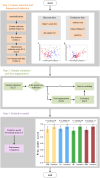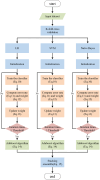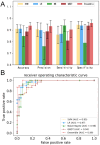Developing a multiomics data-based mathematical model to predict colorectal cancer recurrence and metastasis
- PMID: 40375082
- PMCID: PMC12082861
- DOI: 10.1186/s12911-025-03012-9
Developing a multiomics data-based mathematical model to predict colorectal cancer recurrence and metastasis
Abstract
Background: Colorectal cancer is the fourth most deadly cancer, with a high mortality rate and a high probability of recurrence and metastasis. Since continuous examinations and disease monitoring for patients after surgery are currently difficult to perform, it is necessary for us to develop a predictive model for colorectal cancer metastasis and recurrence to improve the survival rate of patients.
Results: Previous studies mostly used only clinical or radiological data, which are not sufficient to explain the in-depth mechanism of colorectal cancer recurrence and metastasis. Therefore, this study proposes such a multiomics data-based predictive model for the recurrence and metastasis of colorectal cancer. LR, SVM, Naïve-bayes and ensemble learning models are used to build this predictive model.
Conclusions: The experimental results indicate that our proposed multiomics data-based ensemble learning model effectively predicts the recurrence and metastasis of colorectal cancer.
Keywords: Colorectal cancer; Data augmentation; Ensemble learning; Multiomics; Recurrence and metastasis.
© 2025. The Author(s).
Conflict of interest statement
Declarations. Ethics approval and consent to participate: Not applicable. Consent for publication: Not applicable. Competing interests: The authors declare that the research was conducted in the absence of any commercial or financial relationships that could be construed as a potential conflict of interest.
Figures






Similar articles
-
Optimizing prediction of metastasis among colorectal cancer patients using machine learning technology.BMC Gastroenterol. 2025 Apr 18;25(1):272. doi: 10.1186/s12876-025-03841-y. BMC Gastroenterol. 2025. PMID: 40251500 Free PMC article.
-
Large-Scale Analysis of Gene Expression Data Reveals a Novel Gene Expression Signature Associated with Colorectal Cancer Distant Recurrence.PLoS One. 2016 Dec 9;11(12):e0167455. doi: 10.1371/journal.pone.0167455. eCollection 2016. PLoS One. 2016. PMID: 27935967 Free PMC article.
-
Monoclonal immunoscintigraphy for detection of metastasis and recurrence of colorectal cancer.World J Gastroenterol. 2011 May 21;17(19):2424-30. doi: 10.3748/wjg.v17.i19.2424. World J Gastroenterol. 2011. PMID: 21633643 Free PMC article.
-
Clinical practice. Surveillance strategies after curative treatment of colorectal cancer.N Engl J Med. 2004 Jun 3;350(23):2375-82. doi: 10.1056/NEJMcp010529. N Engl J Med. 2004. PMID: 15175439 Review. No abstract available.
-
Surveillance after colorectal cancer resection.Lancet. 2000 Jan 29;355(9201):395-9. doi: 10.1016/S0140-6736(99)06552-6. Lancet. 2000. PMID: 10665570 Review. No abstract available.
Cited by
-
DGHNN: a deep graph and hypergraph neural network for pan-cancer related gene prediction.Bioinformatics. 2025 Jul 1;41(7):btaf379. doi: 10.1093/bioinformatics/btaf379. Bioinformatics. 2025. PMID: 40580449 Free PMC article.
References
-
- Dekker E, Tanis PJ, Vleugels JLA, Kasi PM, Wallace MB. Colorectal cancer. Lancet. 2019;394(10207):1467–80. - PubMed
-
- Turajlic S, Swanton C. Metastasis as an evolutionary process. Science. 2016;352(6282):169. - PubMed
-
- Sargent D, Sobrero A, Grothey A, O’Connell MJ, Buyse M, Andre T, Zheng Y, Green E, Labianca R, O’Callaghan C, et al. Evidence for cure by adjuvant therapy in colon cancer: observations based on individual patient data from 20,898 patients on 18 randomized trials. J Clin Oncol. 2009;27(6):872–7. - PMC - PubMed
-
- Biglarian A, Bakhshi E, Gohari MR, Khodabakhshi R. Artificial neural network for prediction of distant metastasis in colorectal cancer. Asian Pac J Cancer Prev. 2012;13(3):927–30. - PubMed
MeSH terms
Grants and funding
- 2021YFF1201200/National Major Science and Technology Projects of China
- 62372316/National Science Fundation
- 2024YFHZ0091/Key Projects of Sichuan Provincial Department of Science and Technology
- 2025YFHZ0066/Key Projects of Sichuan Provincial Department of Science and Technology
- 2024ZD0532900/National Science and Technology Major Project
LinkOut - more resources
Full Text Sources
Medical

